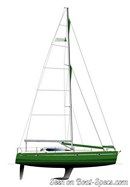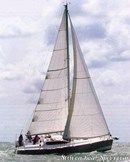RM 1200
Sailboat specifications
The RM 1200 is a 39’4” (11.99m) fast cruising sailboat designed by Marc Lombard Yacht Design Group (France). She was built between 2003 and 2012 by Fora Marine (France).
RM 1200's main features
- Model
- RM 1200
- Hull type
- Monohull
- Category
- Offshore fast cruising sailboat
- Sailboat builder
- Sailboat designer
- Sailboat range
- Country
- France
- Construction
- Hull and deck: plywood with glass/epoxy stratification
- First built hull
- 2003
- Last built hull
- 2012
- Appendages
- Twin keel : twin asymmetric fin with bulb
- Helm
- Single tiller
- Rudder
- Single spade rudder
- Unsinkable
- No
- Trailerable
- No
- EC design categoryiThe CE design category indicates the ability to cope with certain weather conditions (the sailboat is designed for these conditions)
A: Wind < force 9, Waves < 10m
B: Wind < force 8, Waves < 8m
C: Wind < force 6, Waves < 4m
D: Wind < force 4, Waves < 0,5m - A
- Standard public price ex. VAT (indicative only)
- N/A €
RM 1200's main dimensions
- Hull length
- 39’ 4”11.99 m
- Waterline length
- 37’11.28 m
- Beam (width)
- 13’ 10”4.22 m
- Waterline beam (width)
- 10’ 10”3.3 m
- Draft
- 5’ 11”1.8 m
- Light displacement (MLC)
- 14991 lb6800 kg
- Maximum displacement (MLDC)
- 18298 lb8300 kg
- Ballast weight
- 5952 lb2700 kg
- Ballast type
- Cast iron
RM 1200's rig and sails
- Upwind sail area
- 996 ft²92.5 m²
- Downwind sail area
- 1631 ft²151.5 m²
- Mainsail area
- 501 ft²46.5 m²
- Genoa area
- 495 ft²46 m²
- Jib area
- 258 ft²24 m²
- Symmetric spinnaker area
- 1130 ft²105 m²
- IiFore triangle height (from mast foot to fore stay top attachment)
- 51’ 10”15.8 m
- JiFore triangle base (from mast foot to bottom of forestay)
- 16’ 7”5.05 m
- PiMainsail hoist measurement (from tack to head)
- 49’ 6”15.1 m
- EiMainsail foot measurement (from tack to clew)
- 17’ 4”5.26 m
- Rigging type
- Cutter Marconi fractional
- Mast configuration
- Deck stepped mast
- Rotating spars
- No
- Number of levels of spreaders
- 2
- Spreaders angle
- Swept-back
- Spars construction
- Aluminum spars
- Standing rigging
- 1x19 strand wire discontinuous
RM 1200's performances
- HN (French rating)iHN or "Handicap Nationale" is an empirical rating system used in France allowing various monohulls, of different sizes and designs, to race each other fairly. It is particularly suitable for cruiser and cruiser-racer. Therefore, by comparing these values, we can have an indication of the relative speed of 2 boats.
- 28.5
- Upwind sail area to displacementiThe ratio sail area to displacement is obtained by dividing the sail area by the boat's displaced volume to the power two-thirds.
The ratio sail area to displacement can be used to compare the relative sail plan of different sailboats no matter what their size.
Upwind: under 18 the ratio indicates a cruise oriented sailboat with limited performances especially in light wind, while over 25 it indicates a fast sailboat. - 277 ft²/T25.77 m²/T
- Downwind sail area to displacementiThe ratio sail area to displacement is obtained by dividing the sail area by the boat's displaced volume to the power two-thirds.
The ratio sail area to displacement can be used to compare the relative sail plan of different sailboats no matter what their size. - 454 ft²/T42.21 m²/T
- Displacement-length ratio (DLR)iThe Displacement Length Ratio (DLR) is a figure that points out the boat's weight compared to its waterline length. The DLR is obtained by dividing the boat's displacement in tons by the cube of one one-hundredth of the waterline length (in feet).
The DLR can be used to compare the relative mass of different sailboats no matter what their length:
a DLR less than 180 is indicative of a really light sailboat (race boat made for planning), while a DLR greater than 300 is indicative of a heavy cruising sailboat. - 134
- Ballast ratioiThe Ballast ratio is an indicator of stability; it is obtained by dividing the boat's displacement by the mass of the ballast. Since the stability depends also of the hull shapes and the position of the center of gravity, only the boats with similar ballast arrangements and hull shapes should be compared.
The higher the ballast ratio is, the greater is the stability. - 40 %
- Critical hull speediAs a ship moves in the water, it creates standing waves that oppose its movement. This effect increases dramatically the resistance when the boat reaches a speed-length ratio (speed-length ratio is the ratio between the speed in knots and the square root of the waterline length in feet) of about 1.2 (corresponding to a Froude Number of 0.35) . This very sharp rise in resistance, between speed-length ratio of 1.2 to 1.5, is insurmountable for heavy sailboats and so becomes an apparent barrier. This leads to the concept of "hull speed".
The hull speed is obtained by multiplying the square root of the waterline length (in feet) by 1.34. - 8.15 knots
RM 1200's auxiliary engine
- Engine(s)
- 1 inboard engine
- Engine(s) power (min./max.)
- 40 HP / 50 HP
- Fuel type
- Diesel
- Fuel tank capacity
- 39.6 gal150 liters
RM 1200's accommodations and layout
- Cockpit
- Open aft cockpit
- Cabin(s)
- 2
- Berth(s)
- 10
- Head(s)
- 1
- Freshwater tank capacity
- 184.9 gal700 liters
- Holding tank capacity
- 7.9 gal30 liters
- Fridge/ice-box capacity
- 35.7 gal135 liters
- Maximum headroom
- 6’ 7”2 m
- Galley headroom
- 6’ 2”1.88 m
- Head headroom
- 6’ 7”2 m
RM 1200's saloon
- Maximum headroom
- 5’ 10”1.76 m
- Saloon table width
- 2’ 4”0.7 m
- Berth length
- 7’ 1”2.15 m
- Chart table
- 3’ 4”1.02 m x 1’ 10”0.54 m
- Berth width
- 2’ 5”0.74 m
RM 1200's fore cabin
- Maximum headroom
- 5’ 8”1.75 m
- Berth length
- 6’ 7”2 m
- Berth width
- 4’ 7”1.4 m
RM 1200's aft cabin
- Berth length
- 6’ 7”2 m
- Berth width
- 4’ 5”1.35 m



Fora Marine RM 1200 sailplan - - 2/5
Picture extracted from the commercial documentation © Fora Marine
Picture extracted from the commercial documentation © Fora Marine



Fora Marine RM 1200 sailing - - 4/5
Picture extracted from the commercial documentation © Fora Marine
Picture extracted from the commercial documentation © Fora Marine


Fora Marine RM 1200 interior and accommodations - - 5/5
Picture extracted from the commercial documentation © Fora Marine
Picture extracted from the commercial documentation © Fora Marine
Similar sailboats that may interest you:
Sailboats
First built hull
Hull length
2013
44’ 7”13.6 m
1998
34’ 5”10.47 m
1988
52’ 6”16 m
2016
45’ 4”13.8 m
2015
39’ 10”12.12 m
2016
31’ 8”9.65 m
2016
40’ 8”12.41 m
2016
41’12.5 m
2017
40’12.2 m
2017
50’ 11”15.51 m
2017
44’ 11”13.68 m
2019
38’ 8”11.8 m
2013
29’ 2”8.9 m
2015
35’ 1”10.69 m
2012
37’ 4”11.38 m